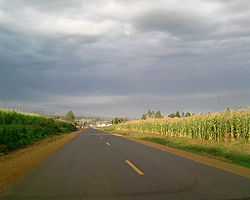Our website is made possible by displaying online advertisements to our visitors.
Please consider supporting us by disabling your ad blocker.
Migori County
Migori | |
|---|---|
| Migori County | |
 Close to Awendo Town, Migori | |
 Location in Kenya | |
| Country | |
| Formed | 4 March 2013 |
| Capital | Migori |
| Government | |
| • Governor | Ochilo Ayacko |
| Area | |
• Total | 2,586.4 km2 (998.6 sq mi) |
| Population (2019) | |
• Total | 1,116,436 |
| • Density | 430/km2 (1,100/sq mi) |
| Time zone | UTC+3 (EAT) |
| Website | migori.go.ke |
Migori County is a county in the former Nyanza Province of southwestern Kenya. It borders Homa Bay County to the north, Kisii County to the northeast, Narok County to the southeast, Tanzania to the west and south, and Lake Victoria to the west. The county also borders Uganda via Migingo Island in Lake Victoria. The county's headquarter is Migori, which is also its largest town. In the 2019 National Census, Migori County had a population of 1,116,436, almost 200,000 more than the 917,170 recorded in 2009.[1]
Migori County is located in the sugar belt wetlands of western Kenya and is at the heart of the African tropics. However, the county enjoys a pleasant climate due to its high altitude which modifies the climate alongside the cool breeze from Lake Victoria.
Demographically, Migori County is the most diverse region of the former Nyanza Province after Kisumu County. Its inhabitants include the Suba, Joluo, Kuria, Abagusii, Luhya, Somalis, Indians, Arabs, Agikuyu and Nubians.
The county is important to Kenya because of the significance of Isebania border post to the East African economy, the A-1 Kenya -Tanzania road cuts the county in half, Sony (South Nyanza) Sugar Company, Lake Victoria and food sustainability of Western region of Kenya and the meat industry courtesy of the ranches in Kurialand and Suna West.
Migori town serves as in important link between Kenya and Tanzania and the second most viable commercial center in Luo-Nyanza after Kisumu. Other major towns in Migori county include Kehancha, Rongo, Awendo and Isebania in Kuria District.
Previous Page Next Page


